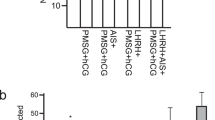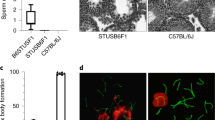Abstract
An autosomal recessive mutation (ipv) causing infertility in homozygous females (ipv/ipv) because of imperforate vaginae was discovered in a line of mice selected for low lean tissue mass as a proportion of body weight. The aim of this study was to determine if the mutation could be propagated in offspring following embryo transfer of oocytes collected from mutant females and fertilized in vitro with sperm from males known to carry the gene (ipv/?). Caudal epididymal sperm were incubated with cumulus-enclosed oocytes for 8–10 hr in tissue culture medium 199+5% fetal calf serum +0.4% bovine serum albumin. Oocytes possessing at least two pronuclei were transferred to recipient CD-1 females which had been mated 24 hr earlier to vasectomized males. A total of 683 oocytes was collected from 27 superovulated mutant females. A large proportion of the oocytes was abnormal as evidenced by cytoplasmic fragmentation (259/683, 38%). Seventy-eight percent (331/424) of the normal oocytes were fertilized and 181 of these were transferred to 10 recipients. Six of 10 recipients delivered 38 offspring (24 females, 14 males). Fifty-eight percent (14/24) of the female offspring displayed an imperforate vagina. The results demonstrate that in vitro fertilization and embryo transfer can be used for propagating a mutant gene that causes infertility in females.
Similar content being viewed by others
References
Eisen EJ, Hauser ME, Pomp D, Anderson SG, Newbold RR, McCormick GY: A recessive mutation causing imperforate vagina in mice. J Hered 1989;80:478–482
Gowen JW, Heidenthal G: Imperforate in the mouse, its inheritance and relation to endocrine function. J Exp Zool 1942;89:433–450
Chase EB: Inheritance of imperforate vagina in the mouse. J Hered 1954;35:363–364.
Strong LC, Hollander WF: Heredity loop-tail in the house mouse. J Hered 1949;40:329–334
Searle AG: The genetics and morphology of two “luxoid” mutants in the house mouse. Genet Res Camb 1964;5:171–197
Edwards RG, Steptoe PC, Purdy JM: Establishing full-term human pregnancies using cleaving embryosin vitro. Br J Obstet Gyn 1980;87:737–741
Trounson AO, Leeton JF, Wood C, Webb J, Wood J: Pregnancies in humans by fertilizationin vitro and embryo transfer in the controlled ovulatory cycle. Science 1981;212:681–682
Eisen EJ: Selection for components related to body composition in mice: Direct responses. Theor Appl Genet 1987;74:393–801
Chang MC: Fertilization of rabbit ovain vitro. Nature 1959;184:466–467
Hewitt J, Cohen J, Krishnaswamy V, Fehilly CB, Steptoe BC, Walters DE: Treatment of idiopathic infertility, cervical mucus hostility and male infertility: Artificial insemination with husband's semen orin vitro fertilization? Fertil Steril 1985;44:350–355
Sirard MA, Lambert RD, Menard DP, Bedoya M: Pregnancies afterin-vitro fertilization of cow follicular oocytes, their incubation in rabbit oviduct and their transfer to the cow uterus. J Reprod Fert 1985;75:551–556
Miyamoto H, Chang MC: Fertilizationin vitro of mouse and hamster eggs after the removal of follicular cells. J Reprod Fert 1972;30:309–312
Fraser LR, Drury LM: Effect of removal of epididymal secretions on fertilizationin vitro of mouse eggs. J Reprod Fert 1976;48:125–128
Leipold HW, Saperstein G: Rectal and vaginal constriction in Jersey cattle. JAVMA 1975;166:231–232
Deas DW, Melrose DR, Reed HCB, Van de Plassche M, Pidduck H: Other non-infectious abnormalities.In Fertility and Infertility in Domestic Animals, JA Laing (ed). London, Bailliere Tindall, 1979, pp 137–159
Finocchio EJ, Hales WS, Wolfe DL: Persistent median wall of the mullerian duct system in a two-year old filly. Vet Med 1968;63:622
Teige J: Congenital malformations of the Mullerian ducts and sinus urogenitalis in pigs. Nord Vet Med 1957;9:609–629
Barbolt TA, Brown GL: Vaginal septum in the rat. Lab Anim 1989;18:47–48
Cunliffe-Beamer TL, Feldman DB: Vaginal septa in mice: Incidence, inheritance and effect on reproduction performance. Lab Anim Sci 1976;26:895–898
Shire JGM: Studies on the inheritance of vaginal septa in mice, a trait with low penetrance. J Reprod Fert 1984;70:333–339
Stephens FD: The Mayer-Rokitansky syndrome. J Urol 1986;135:109–113
Bonner JT: Vaginal septa frequence influenced by major histocompatability complex, H-2. J Immunogenet 1981;8:455–458
Author information
Authors and Affiliations
Rights and permissions
About this article
Cite this article
Didion, B.A., Hauser, M.E. & Eisen, E.J. Use of in vitro fertilization and embryo transfer to circumvent infertility caused by an inherited imperforate vagina in mice. J Assist Reprod Genet 8, 167–172 (1991). https://doi.org/10.1007/BF01131709
Received:
Accepted:
Issue Date:
DOI: https://doi.org/10.1007/BF01131709




